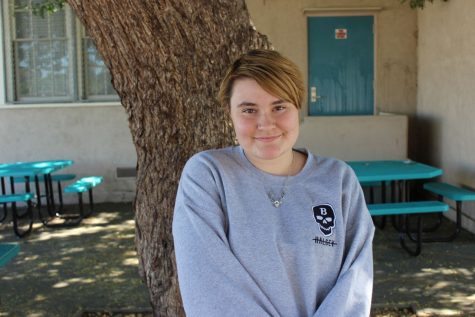Teens face the common villain called suicide
April 13, 2016
Students of Daniel Pearl Magnet High School are all too familiar with teen suicide due to junior Rebecca Becerra’s death

Seniors Valentina Comar and Sindy Saravia walk beside each other clad in their Rebecca Becerra shirts in remembrance of her. Bacerra committed suicide last year in May. Students were deeply impacted by her death and adorn themselves in yellow ribbons to fight teen suicide.
in May 2015.
“We didn’t know anything because she always seemed fine,” said senior Monica Hernandez, one of Becerra’s closest friends. “We thought she would be the last person to do something like that. She just always seemed so happy.”
Becerra was just one in about 37,500 deaths caused by suicide last year in the United States according to Suicide Is Preventable.
“I was shocked and I was confused,” Hernandez said. “But it made me think differently. Now, I look at people and I don’t judge them as harshly because I don’t know what they’re going through. I don’t know if they’re having a bad day.”
Suicide causes more deaths than car accidents or any other cause of injury. According to the World Health Organization, suicide is the third leading cause of death in the world for those 15 to 24 years old.
Considering or attempting suicide is indicative of a treatable mental disorder. According to Grief Speaks, about 90% of people who attempt or commit suicide try to reach out for help, such as telling a trusted friend or seeing a doctor shortly before the attempt or suicide.
“It sometimes starts with simple depression signs, like sadness,” said Eliana Lichtman, school psychologist. “It can escalate to hopeless talk, like there’s no point in living.”
Most people who are seriously considering suicide show warning signs. These warning signs can be as noticeable as saying a heartfelt goodbye to friends or family members at odd times, or as subtle as simply joking about suicide. Slight comments about how everything would be better without them and showing an increased or unusual interest in death or dying should also cause you to be more alert.
“A big red flag is if they start giving away prized possessions,” Lichtman said.
Often times, suicidal individuals describe their lives as meaningless or out of their control. And though suicidal emotions range, some people may experience high levels of anxiety while others experience drastic mood swings.
Suicide Prevention Awareness and Support states that about 25% of suicidal individuals, including Becerra, do not show any warning signs at all. But those who do show signs report feeling hopeless, helpless, trapped, and sometimes, extremely angry.
Other people lose interest in past hobbies or experience a change in sleeping or eating habits. Some even experience a withdrawal from family and friends and a change in their personality.
“If someone realizes they’re feeling hopeless, ideally they should speak to an adult who can connect them with resources that can help,” Lichtman said.
Any talk of suicide is serious and should be taken seriously. Pain isn’t always obvious to other people, but if you notice even one warning sign, speak up and help.
“Letting them know how much people care about them and giving them hope is so crucial,” Lichtman said. “The hope that they don’t have to endure all this pain. There are ways to get them help other than cutting their life short.”








